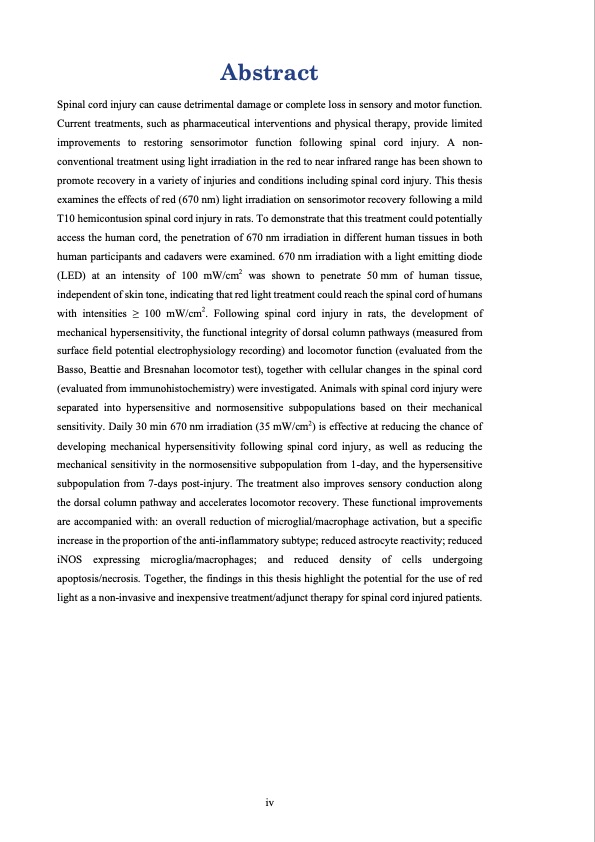
PDF Publication Title:
Text from PDF Page: 004
Abstract Spinal cord injury can cause detrimental damage or complete loss in sensory and motor function. Current treatments, such as pharmaceutical interventions and physical therapy, provide limited improvements to restoring sensorimotor function following spinal cord injury. A non- conventional treatment using light irradiation in the red to near infrared range has been shown to promote recovery in a variety of injuries and conditions including spinal cord injury. This thesis examines the effects of red (670 nm) light irradiation on sensorimotor recovery following a mild T10 hemicontusion spinal cord injury in rats. To demonstrate that this treatment could potentially access the human cord, the penetration of 670 nm irradiation in different human tissues in both human participants and cadavers were examined. 670 nm irradiation with a light emitting diode (LED) at an intensity of 100 mW/cm2 was shown to penetrate 50 mm of human tissue, independent of skin tone, indicating that red light treatment could reach the spinal cord of humans with intensities ≥ 100 mW/cm2. Following spinal cord injury in rats, the development of mechanical hypersensitivity, the functional integrity of dorsal column pathways (measured from surface field potential electrophysiology recording) and locomotor function (evaluated from the Basso, Beattie and Bresnahan locomotor test), together with cellular changes in the spinal cord (evaluated from immunohistochemistry) were investigated. Animals with spinal cord injury were separated into hypersensitive and normosensitive subpopulations based on their mechanical sensitivity. Daily 30 min 670 nm irradiation (35 mW/cm2) is effective at reducing the chance of developing mechanical hypersensitivity following spinal cord injury, as well as reducing the mechanical sensitivity in the normosensitive subpopulation from 1-day, and the hypersensitive subpopulation from 7-days post-injury. The treatment also improves sensory conduction along the dorsal column pathway and accelerates locomotor recovery. These functional improvements are accompanied with: an overall reduction of microglial/macrophage activation, but a specific increase in the proportion of the anti-inflammatory subtype; reduced astrocyte reactivity; reduced iNOS expressing microglia/macrophages; and reduced density of cells undergoing apoptosis/necrosis. Together, the findings in this thesis highlight the potential for the use of red light as a non-invasive and inexpensive treatment/adjunct therapy for spinal cord injured patients. ivPDF Image | Effects of Red Light Treatment on Spinal Cord Injury

PDF Search Title:
Effects of Red Light Treatment on Spinal Cord InjuryOriginal File Name Searched:
Thesis_Di Hu_final.pdfDIY PDF Search: Google It | Yahoo | Bing
Cruise Ship Reviews | Luxury Resort | Jet | Yacht | and Travel Tech More Info
Cruising Review Topics and Articles More Info
Software based on Filemaker for the travel industry More Info
The Burgenstock Resort: Reviews on CruisingReview website... More Info
Resort Reviews: World Class resorts... More Info
The Riffelalp Resort: Reviews on CruisingReview website... More Info
| CONTACT TEL: 608-238-6001 Email: greg@cruisingreview.com | RSS | AMP |